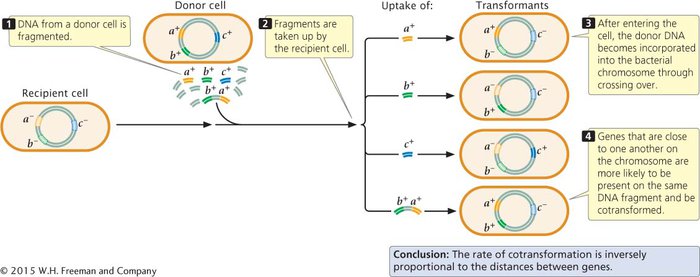Transformation
A second way that DNA can be transferred between bacteria is through transformation (see Figure 7.7b). Transformation played an important role in the initial identification of DNA as the genetic material, as we will see in Chapter 8.
Transformation requires both the uptake of DNA from the surrounding medium and its incorporation into a bacterial chromosome or a plasmid. It may occur naturally when dead bacteria break down and release DNA fragments into the environment. In soil and marine environments, transformation may be an important route of genetic exchange for some bacteria.
MECHANISM OF TRANSFORMATION Cells that take up DNA through their cell membrane are said to be competent. Some species of bacteria take up DNA more easily than do others; competence is influenced by growth stage, the concentration of available DNA, and environmental challenges. The DNA taken up by a competent cell need not be bacterial: virtually any type of DNA (bacterial or otherwise) can be taken up by competent cells under the appropriate conditions.
Typically, as a DNA fragment enters a bacterial cell in the course of transformation (Figure 7.16), one of the strands is hydrolyzed, whereas the other strand moves across the membrane, where it may pair with a homologous region and become integrated into the bacterial chromosome. This integration requires two crossover events, after which the remaining single-

Bacterial geneticists have developed techniques to increase the frequency of transformation in the laboratory to introduce particular DNA fragments into cells. They have also developed strains of bacteria that are more competent than wild-
GENE MAPPING WITH TRANSFORMATION Transformation, like conjugation, can be used to map bacterial genes, especially in those species that do not undergo conjugation or transduction (see Figure 7.7a and c). Transformation mapping requires two strains of bacteria that differ in several genetic traits; for example, the recipient strain might be a− b− c− (auxotrophic for three nutrients), and the donor strain might be a+ b+ c+ (prototrophic for the same three nutrients). DNA from the donor strain is isolated, purified, and fragmented. The recipient strain is treated to increase competence, and DNA from the donor strain is added to the medium. Fragments of the donor DNA enter the recipient cells and undergo recombination with homologous DNA sequences on the bacterial chromosome.
Genes can be mapped by observing the rate at which two or more genes are transferred together, or cotransformed, in transformation. Genes that are physically close on the chromosome are more likely to be present on the same DNA fragment and transferred together, as shown for genes a+ and b+ in Figure 7.17. Genes that are far apart are unlikely to be present on the same DNA fragment and will rarely be transferred together. Inside the cell, DNA becomes incorporated into the bacterial chromosome through recombination. If two genes are close together on the same fragment, any two crossovers are likely to take place on either side of the two genes, allowing both to become part of the recipient chromosome. If the two genes are far apart, there may be one crossover between them, allowing one gene but not the other to recombine with the bacterial chromosome. Thus, two genes are more likely to be incorporated into the recipient chromosome together when they are close together on the donor chromosome, and genes located far apart are rarely cotransformed. If genes a and b are frequently cotransformed, and genes b and c are frequently cotransformed, but genes a and c are rarely cotransformed, then gene b must be between a and c—the gene order is a b c.

CONCEPTS
Bacterial genes can be mapped by taking advantage of transformation—
 CONCEPT CHECK 4
CONCEPT CHECK 4
A bacterial strain with genotype his− leu− thr− is transformed with DNA from a strain that is his+ leu+ thr+. A few leu+ thr+ cells and a few his+ thr+ cells are found, but no his+ leu+ cells are observed. Which genes are farthest apart?
his and leu